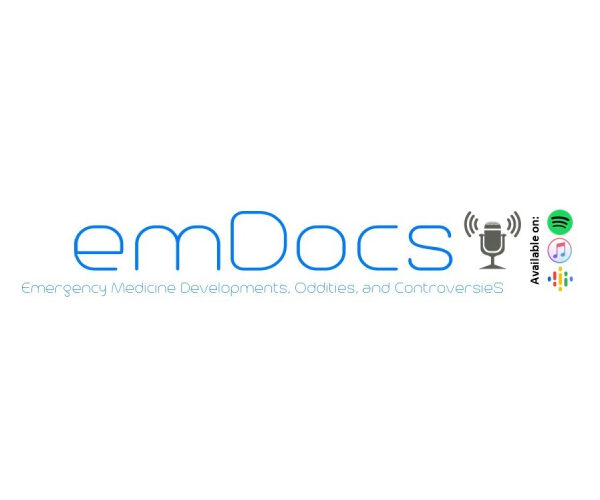Welcome to the emDOCs Videocast – please subscribe to our YouTube channel. These videos will cover post summaries, takehomes on clinical condition, and EBM/guideline literature updates. Today we focus on acute brain injury, including the effects of hypotension, antibiotics in mechanically ventilated patients, transfusion thresholds, and ventilation strategies.
Article #1: Lee JW, Wang W, Rezk A, et al. Hypotension and Adverse Outcomes in Moderate to Severe Traumatic Brain Injury: A Systematic Review and Meta-Analysis. JAMA Netw Open. 2024 Nov 4;7(11):e2444465.
Clinical Question:
- In patients with moderate to severe TBI, is hypotension associated with adverse outcomes?
Design:
- Systematic review and meta-analysis.
- Included RCTs and cohort studies evaluating patients > 10 years with moderate to severe TBI and hypotension.
- Excluded studies with mild TBI.
Outcomes:
- Hypotension with death and/or vegetative state within 6 months and incidence of hypotension
Results:
- 51 studies with 384,329 patients.
- Overall hypotension incidence 18% (95% CI, 12%-26%) (P < .001;I2 = 99.84%).
- Significant increase in mortality in patients with hypotension and moderate to severe TBI (crude OR, 3.82; 95% CI, 3.04-4.81;P < .001; I2 = 96.98%; adjusted OR, 2.22; 95% CI, 1.96-2.51; P < .001; I2 = 92.21%).
Considerations:
- No reported data on vegetative state, and lack of uniformity of reported data.
- Limited data on duration of hypotension and management of hypotension.
- High heterogeneity in mortality outcome data, reducing generalizability and applicability.
The Bottom Line:
- Hypotension in patients with moderate to severe TBI is associated with higher mortality.
Article #2: Dahyot-Fizelier C, Lasocki S, Kerforne T, et al; PROPHY-VAP Study Group and the ATLANREA Study Group. Ceftriaxone to prevent early ventilator-associated pneumonia in patients with acute brain injury: a multicentre, randomised, double-blind, placebo-controlled, assessor-masked superiority trial. Lancet Respir Med. 2024 May;12(5):375-385.
Background:
- Ventilator-associated pneumonia (VAP), or infection-related ventilator-associated complication (IVAC), is a nosocomial pneumonia occurring on day 3 of mechanical ventilation that was preceded by 2 days of stable or decreasing ventilator requirements.
- Overall incidence is 5-40%, but in patients with TBI, the risk may reach 60%.
Clinical Question:
- In adults with severe brain injury who require invasive mechanical ventilation (IMV), does an early, single dose of ceftriaxone compared with placebo reduce early VAP?
Design:
- Multicenter, double-blind, placebo-controlled RCT; conducted at nine ICUs at 8 French hospitals.
- Included adults with GCS < 12, within 12 hr of intubation and within 48 hr of hospitalization, expected IMV duration > 48 hr.
- Brain injury: defined as head trauma, stroke, subarachnoid hemorrhage
- Patients randomized to single dose of ceftriaxone 2 g IV versus placebo.
- All patients underwent standard VAP-preventative measures: Hand washing before any care, Head of bed elevation at 30 degrees mounted every 4 hours, Preferential use of heat and humidity exchange filters, changed only when soiled, Monitoring of cuff pressure of tracheal tube every 8 hours to maintain pressure between 25-30 cm H20, Tracheal aspiration using sterile equipment, and only when required, Mouth care every 8 hours at minimum, No systemic changes of the respirator circuits, Preferential oral insertion of feeding tubes, Starting enteral feeding as soon as possible, Blood glucose monitoring every 4 hours, Ulcer prophylaxis, Extubation as soon as possible.
Outcomes:
- Primary: Development of early VAP (2ndto 7th day of mechanical ventilation)
- VAP confirmed by 2-3 intensivist committee based on clinical, radiological, microbiological criteria outlined by American Thoracic Society (ATS)
- Clinical criteria: temperature ≥38°C or <36°C, white blood cell count >12,000/mm3 or <4000/mm3, purulent tracheal aspirates
- Radiological criteria: new or changed chest X-ray infiltrate
- Micro criteria: positive respiratory cultures
- VAP confirmed by 2-3 intensivist committee based on clinical, radiological, microbiological criteria outlined by American Thoracic Society (ATS)
- Secondary:
- At ICU discharge or day 28 (whichever came first)
- Development of late VAP (>7 days after intubation)
- Organism identified with development of VAP
- Number ventilator-free days
- Number antibiotic-free days
- Development of ventilator-associated events (VAE)
- Comparison to global number of VAE
- Time from inclusion to first spontaneous breathing trial
- Number patients with ESBL-producing Enterobacteriaceae
- Neuro outcomes: mRS and GCS
- Mortality
- Safety
- At day 60:
- Number ICU-free days
- Number hospital-free days
- Neuro outcomes: mRS and GCS
- Mortality
- At ICU discharge or day 28 (whichever came first)
Results:
- Included 319 patients; 162 ceftriaxone vs. 157 placebo
- Primary outcome: early VAP 14% vs. 32% (HR 0.60; 95% CI 0.38-0.95)
- Secondary outcomes at day 28: Lower VAP risk, fewer median vent days, improved mRS, lower mortality
- Secondary outcomes at day 60: More median ICU/hospital free days, no difference in neuro/mortality
Considerations:
- Study was multicenter, randomized, blinded. Used intention to treat analysis.
- Groups were well balanced.
- Authors used standardized VAP definition and prevention measures.
- Primary outcome controversial, as the detection/diagnosis of VAP is inaccurate.
- Limited generalizability. Definition of VAP is controversial, as diagnosis is inaccurate.
- VAP prevention measures not monitored.
- Limited generalizability.
- Secondary outcomes hypothesis generating.
The Bottom Line:
- A single dose of ceftriaxone likely reduces VAP in intubated patients with severe brain injury.
Article #3: Taccone FS, Rynkowski CB, Møller K, et al; TRAIN Study Group. Restrictive vs Liberal Transfusion Strategy in Patients With Acute Brain Injury: The TRAIN Randomized Clinical Trial. JAMA. 2024 Nov 19;332(19):1623-1633.
Clinical Question:
- In patients with acute brain injury who are intubated and mechanically ventilated, does ventilation with lower VT and higher PEEP versus conventional ventilation improve clinical outcomes?
Design:
- Multicenter, open-label RCT.
- Included adults with TBI who were mechanically ventilated.
Outcomes:
- Primary: Unfavorable neurologic outcome 180 days based on Glasgow Outcome Scale extended.
- Secondary: 28-day mortality, organ failure, ICU LOS, adverse events, cerebral ischemia
Results:
- 806 patients; 393 liberal, 413 restrictive
- Primary outcome unfavorable neurologic outcome: liberal 62.6% vs. restrictive 72.6% (aRR 0.86; 95% CI 0.78-0.95).
- Secondary outcome: No difference in 28-day mortality, organ failure, ICU LOS, but fewer cerebral ischemic events in liberal 8.8% vs. 13.5% (RR 0.65; 95% CI 0.44-0.97).
Considerations:
- Study was multicenter, randomized.
- Blinded outcome assessors, but ICU staff not blinded.
- Groups were well balanced.
- Slow enrollment, requiring two sample size adjustments.
- Most patients enrolled at hospital/ICU day 3; unknown if patients received transfusion prior to enrollment.
- Broad range of neurocritical illnesses included, and serum hemoglobin is a nonspecific surrogate for cerebral oxygenation.
- Limited generalizability. Definition of VAP is controversial, as diagnosis is inaccurate.
The Bottom Line:
- In patients with acute brain injury and anemia, hemoglobin transfusion threshold of 9 g/dL may reduce unfavorable neurologic outcomes at 180 days. Further randomized data needed.
Article #4: Mascia L, Fanelli V, Mistretta A, et al. Lung-Protective Mechanical Ventilation in Patients with Severe Acute Brain Injury: A Multicenter Randomized Clinical Trial (PROLABI). Am J Respir Crit Care Med. 2024 Nov 1;210(9):1123-1131.
Clinical Question:
- In patients with acute brain injury who are intubated and mechanically ventilated, does ventilation with lower VT and higher PEEP versus conventional ventilation improve clinical outcomes?
Design:
- Multicenter, open-label RCT.
- Included adults with TBI who were mechanically ventilated.
Outcomes:
- Primary: Composite endpoint of death, ventilator dependency, and acute respiratory distress syndrome (ARDS) at day 28.
- Secondary: 28-day mortality, organ failure, ICU LOS, adverse events, cerebral ischemia
Results:
- Study stopped early at 190 patients.
- Composite outcome at 28 days was 61.5% and 45.3% (RR 1.35; 95% CI 1.03-1.79).
- Mortality: 28.9% and 15.1% (RR 1.91; 95% CI 1.06-3.42
- Ventilator dependency: 42.3% and 27.9% (RR 1.52; 95% CI 1.01-2.28)
- Incidence of ARDS was 30.8% and 22.1% (RR 1.39; 95% CI 0.85-2.27).
Considerations:
- Study was randomized but open label.
- Study stopped early; requires further study.
The Bottom Line:
- This study suggests adults with acute brain injury may not benefit from lung protective ventilation, but further study is needed.










